Linear lighting is lighting that has an elongated shape, as opposed to being round or square. They often come in the form of light channels and tubes or strip lights. They are a good option for illuminating large spaces due to their wide light spread and their ability to be connected and extended indefinitely. Linear light fixtures can be installed in three main ways—mounted on surfaces, suspended in air, or built into, or ‘recessed’ in, surfaces. Regardless, they are a popular choice in many spaces, such as offices, gas stations, elevators, and more. Read on to discover their applications in detail.
The Development of Linear Lighting
In the early days of the 1950s, linear light channels came only in fluorescent tubes. They were used mostly in industrial spaces, as they required lighting that could illuminate large spaces. When users recognized the efficiency of this design, linear lighting became more widely implemented in various facilities, such as offices, retail spaces, showrooms, gas stations, and even elevators.
Back then, a common problem with fluorescent tubes in the past was that lighting was often interrupted, and light lines had dark spots in places where two fixtures connected. This is because fluorescent light bulbs were big, and that technology was not so advanced for the creation of sleeker light fixtures.
In the early 2000s, linear LED lighting overtook fluorescent tubes in popularity after its introduction. Unlike fluorescent tubes, LEDs allowed for continuous and smooth lighting lines due to the compact size of LEDs. At 5mm, lighting gaps could be bridged easily with no interruption.
LEDs also have a host of other benefits compared to traditional lighting solutions, such as a longer service life, lower energy consumption levels, higher energy efficiency, and a greater variety of colors to choose from. These advantages mean that, naturally, many opt for LEDs as their choice of luminaire in linear lighting.
Types of Linear Lighting Fixtures
There are three main types of linear lighting fixtures: surface mounted, recessed, and suspended. Each carries unique traits, and it is important users understand what their differences are before installation.
Surface Mounted Linear Lighting
For a more traditional look, surface mounted lighting is the way to go. This is when linear light fixtures are directly mounted onto ceilings and walls, and it can be considered a ‘classic’ implementation as it is one of the oldest.
Despite being an older concept, surface mounted lighting is still very popular. This is because linear light fixtures are constantly getting updated in terms of style and functionality. With the use of LED lights, fixtures are now more compact than ever before, especially with LED iBond’s very own internationally patented ‘sandwich’ system.
The system is comprised of a 6mm panel made of two Aluminum Composite Panels (ACPs) that ‘sandwich’ our own high-quality LEDs. At such a slim size, fixtures spawned from this technology are not bulky in the least. When mounted on ceilings and walls, they provide much cleaner lines than chandeliers, pendant lights, and drop lights.
Surface mounted lighting is perfect for spaces with exposed ceilings and spaces in which there is little room between the structural ceiling and the dropdown ceiling, where recessed linear lighting is impossible to install.
Recessed Linear Lighting
For a sleeker look and where minimalism is a priority, offices can opt for recessed linear lighting. In ambient lighting, light channels are implemented recessed into the ceiling, wall, or even floor.
This is a popular solution for modern office lighting, especially in workplaces with lower headroom or those that want a more clean and minimalistic design. Since lights are ‘sunken’ into ceilings, walls, and floors, these lighting fixtures offer clean, uninterrupted lines. For busy and crowded offices, the lack of protruding wires also creates a safer environment.
Additionally, recessed linear lighting can be installed as task lighting. Light tubes can be built into the edges of desks and shelves in the main office space. They can also be built-in under cabinets in office kitchenettes. Just as in the case of ambient lighting, this implementation gives spaces a modern feel.
Suspended Linear Lighting
Suspended linear lighting is a lighting channel that is suspended in the air. Usually implemented on ceilings as ambient lighting, suspended lighting is most frequently used to light up a room.
In offices with high headroom, suspended linear lighting can be hung from ceilings to create a sense of depth and dimension. Suspended light fixtures can also be customized to different lengths and arranged in specific patterns to make office spaces more unique.
Although recessed lighting seems like the natural choice for users who prefer minimalistic designs, it is not the only option. Here at LED iBond, we have created The Plane, a unique luminaire that incorporates a magnetic suspension system. The Plane enables bi-directional light output in warm or natural white light. Specifically, its light output is in the 3,000-4,000K range on the Correlated Color Temperature (CCT) scale.
The CCT scale measures the tone of white light a light bulb emits, from warm (<3000K) to cool (blue >4,000K). Between the two is a true neutral white, which seeks to simulate daylight. CCT is measured in degrees Kelvin (K).
The Plane, at 6,5mm, is an extremely slim lighting panel. With an integrated power supply, no extra cables are needed either. This allows users to create a clean and elegant space.
Where Can Linear Lighting Fixtures Be Installed?
Now that we have gone through the three main types of lighting fixtures, we can look at the places in which they can be implemented—in offices, at gas stations, and even in elevators.
In Offices
Linear lighting fixtures are often employed in offices for a good reason: they are convenient and can provide sufficient illumination to all corners of the room. In both shared workspaces and private home offices, suspended lighting fixtures can create a bright and welcoming atmosphere that will give workers the boost they need to be productive.
Here at LED iBond, we successfully installed 28 units of The Plane in an old warehouse space converted into an office. As the building had been preserved from the 17th century, our vision for this project considered both functionality and aesthetics, and The Plane delivered both.
This modern office lighting solution, suspended from the office’s ceilings, provided efficient and comfortable lighting that allowed employees to focus while at work. At the same time, the soft light output was able to enhance the beautiful wooden beams that formed part of the warehouse’s architecture.
The Plane is equally viable as a home office lighting solution, as it provides outstanding lighting that can boost productivity while creating a comfortable environment.
At Service Stations
Service stations – such as gas stations and charging stations – can benefit from having a mix of all three types of linear LED lighting. Firstly, LED strip lights can be wrapped around the roof of service stations. With advanced technology, these light fixtures can be flexibly cut at any length, fitted horizontally, and even fit comfortably around corners. As LEDs come in various colors, service station lights can be personalized to identify themselves to drivers.
The canopy of the service station—the underside of the roof—can be fitted with recessed linear lighting to ensure easy cleaning, while any indoor spaces such as an accompanying tuck shop or convenience store next to the service station can be fitted with its own unique linear light fixtures, suspended in the air, or mounted on surfaces.
With the possibility of warm, neutral, and cool tones from LEDs, service stations can have some ambiance and perhaps even be transformed into a place of comfort.
In Elevators
While elevator lighting design is not typically on most people’s minds, it is an important element that cannot be overlooked. Glare and excessive heat make elevator rides unpleasant, and elevator downtime from broken lights can be truly inconvenient. In this case, recessed linear lighting makes the best solution.
Firstly, LEDs have long service lives. The average LED bulb on the market has a service life of over 50,000 hours, which is roughly 6 years of continuous use. At LED iBond, this service life doubles to 100,000 hours, as our high-quality LEDs are integrated into our very own panels with superior thermal management.
As most elevators are completely concealed spaces, lights are turned on anytime the elevator is in operation. This is all the time in facilities such as hospitals and apartment buildings where people can be on the move 24 hours a day, 7 days a week. With a long service life, LEDs will not have to be replaced often, which can greatly lessen elevator maintenance time.
Secondly, recessed linear lighting is chosen as elevators often have low headroom and thus are unable to accommodate mounted or suspended fixtures. LED iBond has implemented recessed elevator lighting in the past, lining up LEDs in a circular pattern built into the elevator ceiling. Similarly, recessed LED strip lights can be installed on ceilings and walls.
Get in Touch
Installation options for linear LED lighting fixtures are boundless. While we at LED iBond have worked with various clients over the years, meeting lighting needs for offices, service stations, elevators, and other facilities, we are always open to new ideas.
For more information, please contact Sales on the button below. We look forward to talking to you.













